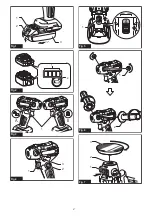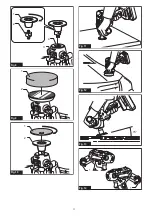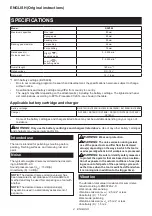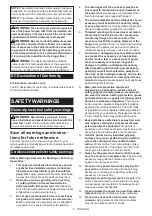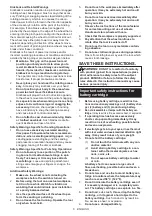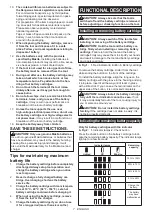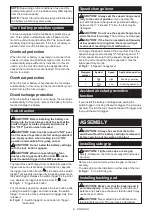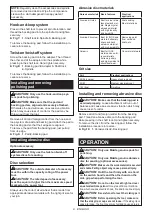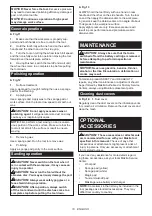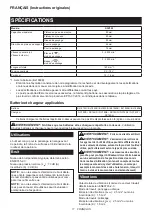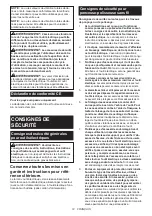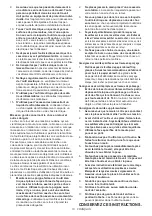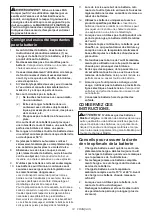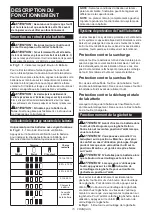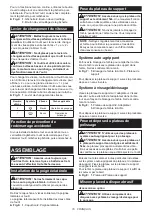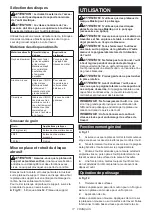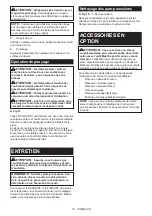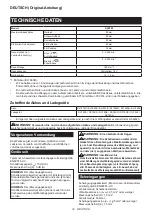
6 ENGLISH
Kickback and Related Warnings
Kickback is a sudden reaction to a pinched or snagged
rotating wheel, backing pad, brush or any other acces-
sory. Pinching or snagging causes rapid stalling of the
rotating accessory which in turn causes the uncon-
trolled power tool to be forced in the direction opposite
of the accessory’s rotation at the point of the binding.
For example, if an abrasive wheel is snagged or
pinched by the workpiece, the edge of the wheel that is
entering into the pinch point can dig into the surface of
the material causing the wheel to climb out or kick out.
The wheel may either jump toward or away from the
operator, depending on direction of the wheel’s move-
ment at the point of pinching. Abrasive wheels may also
break under these conditions.
Kickback is the result of power tool misuse and/or
incorrect operating procedures or conditions and can be
avoided by taking proper precautions as given below.
1.
Maintain a firm grip on the power tool and
position your body and arm to allow you to
resist kickback forces. Always use auxiliary
handle, if provided, for maximum control over
kickback or torque reaction during start-up.
The operator can control torque reactions or kick-
back forces, if proper precautions are taken.
2.
Never place your hand near the rotating acces-
sory.
Accessory may kickback over your hand.
3.
Do not position your body in the area where
power tool will move if kickback occurs.
Kickback will propel the tool in direction opposite
to the wheel’s movement at the point of snagging.
4.
Use special care when working corners, sharp
edges etc. Avoid bouncing and snagging the
accessory.
Corners, sharp edges or bouncing
have a tendency to snag the rotating accessory
and cause loss of control or kickback.
5.
Do not attach a saw chain woodcarving blade
or toothed saw blade.
Such blades create fre-
quent kickback and loss of control.
Safety Warnings Specific for Sanding Operations:
1.
Do not use excessively oversized sanding
disc paper. Follow manufacturers recommen-
dations, when selecting sanding paper.
Larger
sanding paper extending beyond the sanding
pad presents a laceration hazard and may cause
snagging, tearing of the disc or kickback.
Safety Warnings Specific for Polishing Operations:
1.
Do not allow any loose portion of the polish-
ing bonnet or its attachment strings to spin
freely. Tuck away or trim any loose attach-
ment strings.
Loose and spinning attachment
strings can entangle your fingers or snag on the
workpiece.
Additional Safety Warnings:
1.
Make sure the wheel is not contacting the
workpiece before the switch is turned on.
2.
Before using the tool on an actual workpiece,
let it run for a while. Watch for vibration or
wobbling that could indicate poor installation
or a poorly balanced wheel.
3.
Use the specified surface of the wheel to per
-
form the sanding or polishing.
4.
Do not leave the tool running. Operate the tool
only when hand-held.
5.
Do not touch the workpiece immediately after
operation; it may be extremely hot and could
burn your skin.
6.
Do not touch accessories immediately after
operation; it may be extremely hot and could
burn your skin.
7.
Observe the instructions of the manufacturer
for correct mounting and use of wheels.
Handle and store wheels with care.
8.
Check that the workpiece is properly supported.
9.
Pay attention that the wheel continues to
rotate after the tool is switched off.
10.
Do not use the tool on any materials contain-
ing asbestos.
11.
Do not use cloth work gloves during operation.
Fibers from cloth gloves may enter the tool, which
causes tool breakage.
SAVE THESE INSTRUCTIONS.
WARNING:
DO NOT let comfort or familiarity
with product (gained from repeated use) replace
strict adherence to safety rules for the subject
product. MISUSE or failure to follow the safety
rules stated in this instruction manual may cause
serious personal injury.
Important safety instructions for
battery cartridge
1.
Before using battery cartridge, read all instruc-
tions and cautionary markings on (1) battery char-
ger, (2) battery, and (3) product using battery.
2.
Do not disassemble or tamper with the battery car-
tridge.
It may result in a fire, excessive heat, or explosion.
3.
If operating time has become excessively
shorter, stop operating immediately. It may
result in a risk of overheating, possible burns
and even an explosion.
4.
If electrolyte gets into your eyes, rinse them out
with clear water and seek medical attention right
away. It may result in loss of your eyesight.
5.
Do not short the battery cartridge:
(1)
Do not touch the terminals with any con-
ductive material.
(2)
Avoid storing battery cartridge in a con-
tainer with other metal objects such as
nails, coins, etc.
(3)
Do not expose battery cartridge to water
or rain.
A battery short can cause a large current
flow, overheating, possible burns and even a
breakdown.
6.
Do not store and use the tool and battery car-
tridge in locations where the temperature may
reach or exceed 50 °C (122 °F).
7.
Do not incinerate the battery cartridge even if
it is severely damaged or is completely worn
out. The battery cartridge can explode in a fire.
8.
Do not nail, cut, crush, throw, drop the battery
cartridge, or hit against a hard object to the
battery cartridge.
Such conduct may result in a
fire, excessive heat, or explosion.
9.
Do not use a damaged battery.


